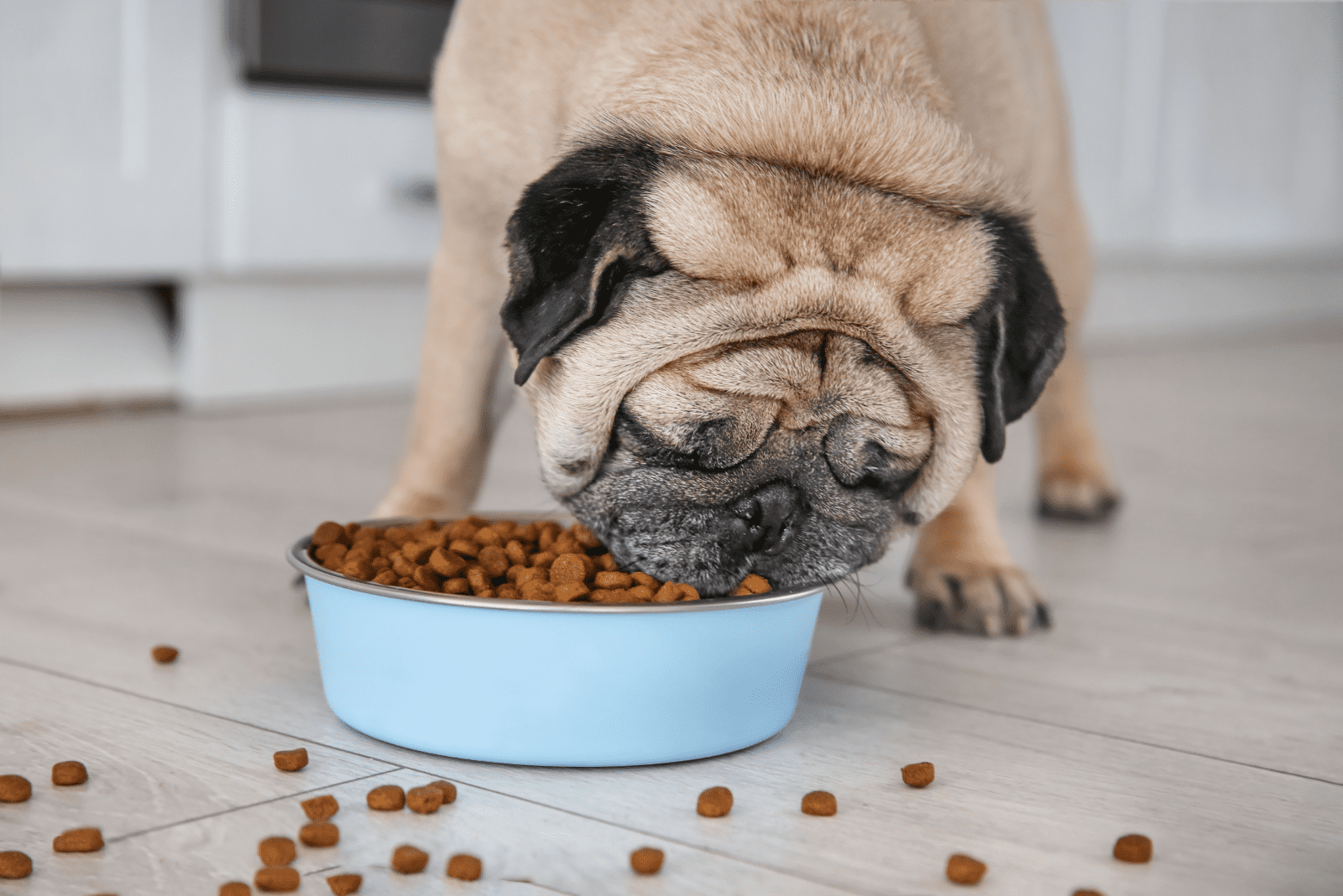Many new dog owners struggle when it comes to the feeding needs of their new pup. The process seems a little bit confusing, and a lot of questions pop up in our minds such as which dog food is the best, how much to feed, and when?
Pugs are no exception. Choosing the right diet for your Pug is extremely important as they are prone to obesity and some other health issues. Puppies especially need a well-balanced, nutrient-dense diet for healthy growth and development.
If you are also struggling with choosing the best Pug diet, do not fret because you are at the right place. PupVine presents you with the Pug Feeding Chart, and all the tips on how to choose the best possible diet that will make your Pug-bug happy and healthy!
Let’s dive into it…
Pug Feeding Chart Explained
We all know Pugs because of their distinctive wrinkly features that make them look so adorable. For many people, they make ideal house dogs, but do you know what those ideal dogs can and cannot eat, or what the appropriate amount of food is for these small-breed dogs?!
Take a look at our Pug feeding chart, and preferably write it down somewhere because it will be very beneficial to you and your beloved pup.
Feeding A Pug Dog
[table id=544 /]
* The amount of food should be separated into equal meals throughout the day at the corresponding number of meals per day.
** Around ten to twelve months of age, your dog should transition to small-breed adult dog food.
How Much Food Should A Pug Eat?
The amount of food you are going to feed your pug will mostly depend on how old your Pug is. When you first get your puppy, he or she should be eight weeks old and already completely weaned off.
The breeder should have already started with puppy food, and the best would be if you continue with the same food for the first couple of weeks until your puppy gets used to the new environment and new life.
After that, you can slowly start introducing the new type of food if you want to. In the beginning, your pup should get around 1 and 1/4 cups of puppy food, separated into equal servings. An adult dog should get around half a cup to one cup of adult dog food.
Senior Pugs need less food because they are not that active anymore and don’t need that much food to stay healthy. 1/3 of a cup should be enough.
Meal Frequency
When puppies are being fed with mother’s milk, they should be eating four to five times a day, or as much as they need to. From eight to 12 weeks of age, puppies should have four meal servings a day.
After that, you can slowly start reducing the number of meals per day, with three times, from four to eight months of age, and two times, from eight months of age, or when you transition to adult dog food.
RELATED: Best Pug Breeders: How To Find A Pug Breeder You Can Trust
Factors Influencing The Pug Feeding Chart
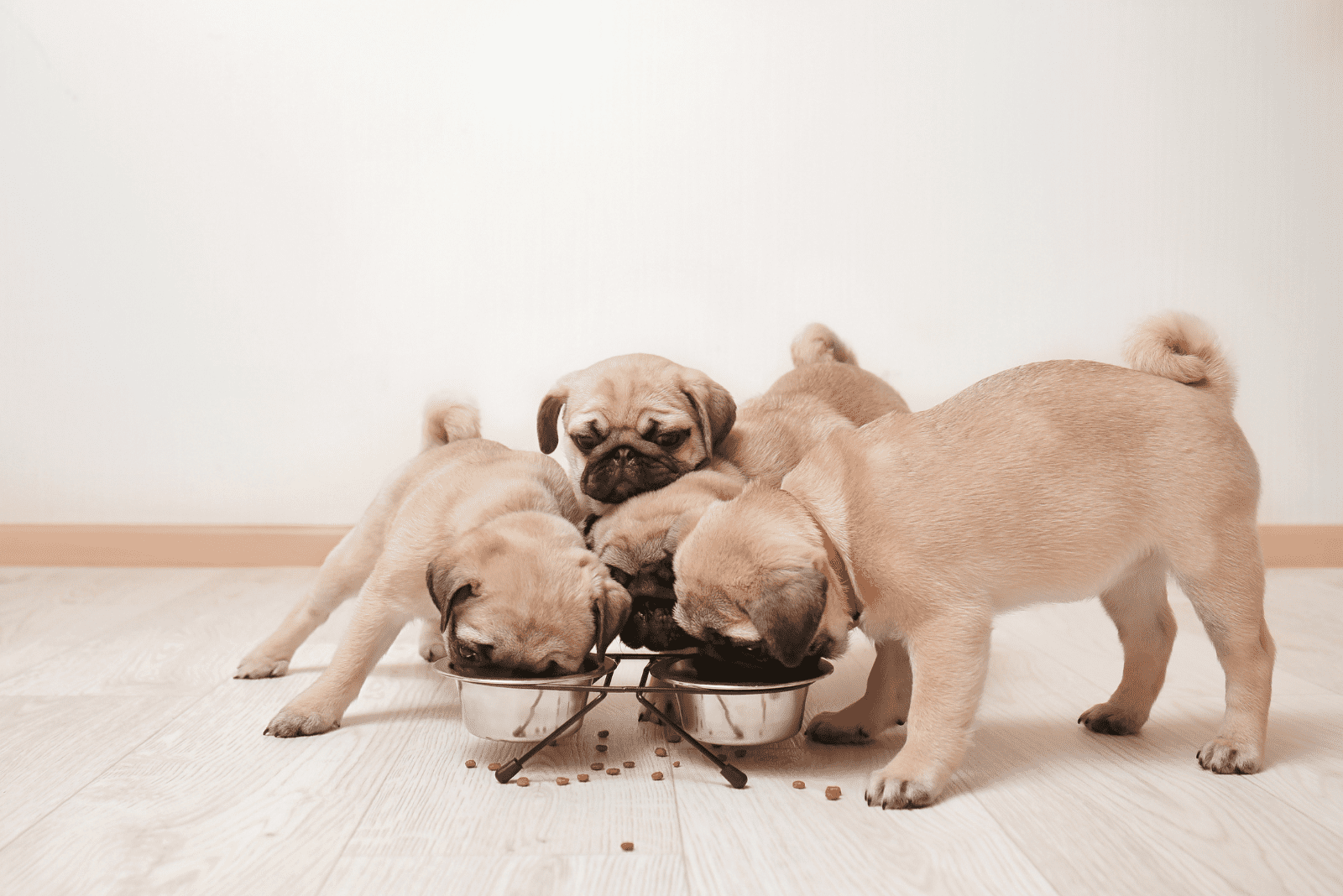
While the Pug feeding chart is a very helpful tool in feeding your new Pug puppy, you need to understand that not every dog is the same. While two Pugs can be from the same breeder and the same litter, they can be completely different, and therefore, their nutrition should not be the same.
There are a couple of factors that might influence the way you should be feeding your pooch, so let’s mention them:
Weight
Weight plays a huge role in how your Pug feeding chart is going to look, and how much food you will be feeding your dog. First things first – you should weigh your dog because a dog that weighs 10 pounds and one that weighs 20 pounds will need completely different food amounts.
You can weigh your dog by yourself at home by using a normal house scale, but if you are unsure of how to do it exactly, you can always go to your vet to get your Pug properly weighed.
Age
Age is another huge factor that influences your dog’s feeding habits. For example, a really small puppy that has just been born should eat only mother’s milk, or if that is not possible, there are some great milk replacers that do the same thing.
As your pup grows, his feeding needs also change. First, you start with Pug puppy food. When your dog is around one year old, he is considered an adult Pug dog, and you should switch to an adult dog food.
Eight +- year-old dogs are considered senior Pugs, and then you need to switch their diet from adult dog food to senior dog food.
Gender
There are slight differences between male and female Pugs, with females usually being slightly smaller than their male examples. This should not affect their feeding habits a lot, but if your female Pug is much smaller, then of course, you need to take that into account.
Pregnancy
If your dog is pregnant, you have to be careful about keeping her ideal weight, especially in the first six weeks because sudden weight gain can increase the risk of problems during birth.
From week six of pregnancy, you need to gradually transition to puppy food since it is higher in vitamins, nutrients, and protein, and overall better for pregnant dogs. Additionally, you need to increase the amount of food by 10% every week until birth.
Nutritional Needs
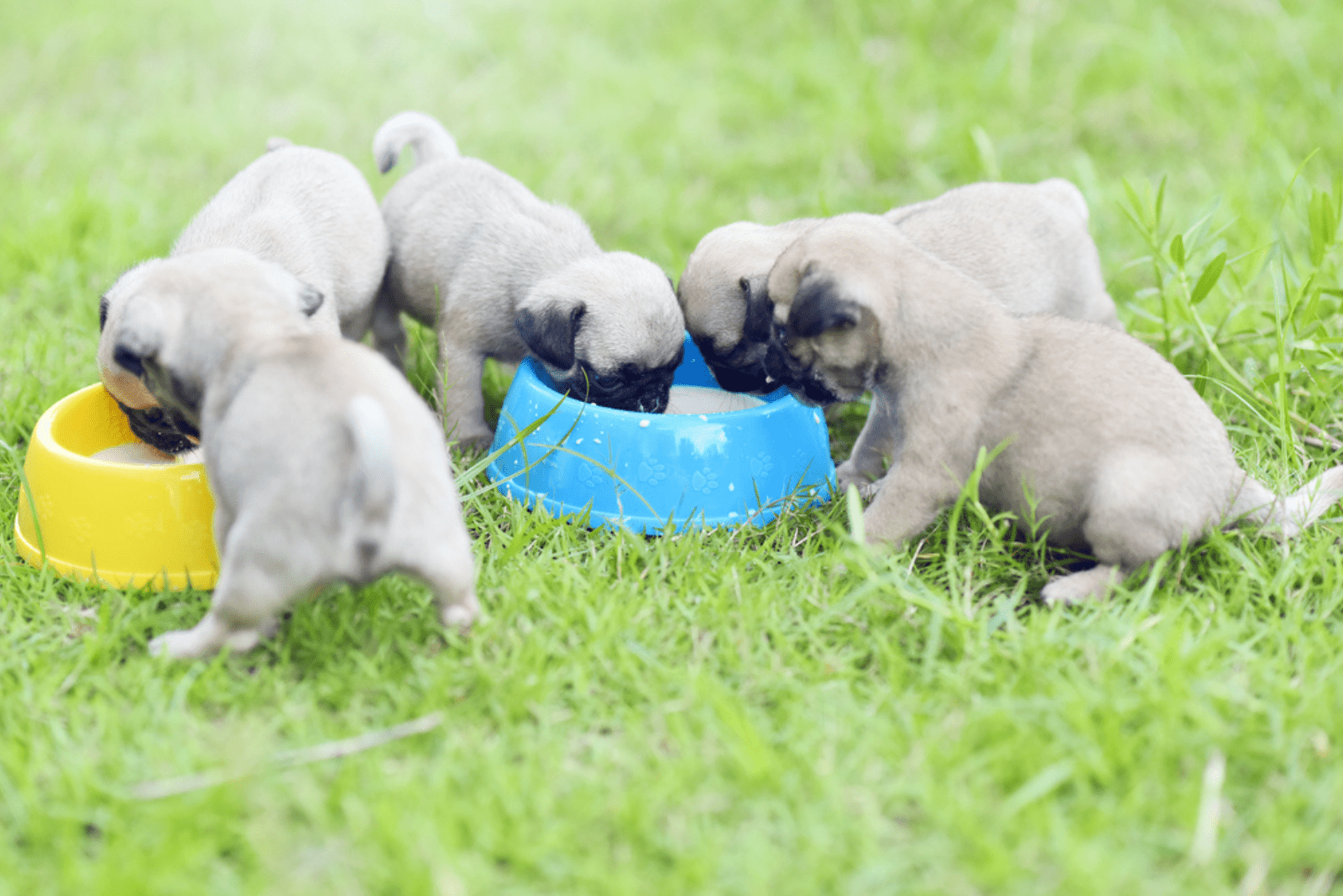
Puppy food
Puppies have completely different nutritional needs than adult or senior dogs. Puppy food should be filled with calories and nutrients because puppies have faster metabolism at that age, and require more good stuff for healthy development.
Usually, puppy food should have at least 25% more calories than adult dog food, and also a lot more protein content to aid their fast growth rate. Other than that, puppy food should also contain a higher amount of omega-3 and omega-6 fatty acids.
Adult food
Adult dog food doesn’t need to have as much protein content as puppy food, and it is really important to make that switch from puppy food to adult food right on time because if not, your pup will soon become overweight.
When it comes to adult food, the important thing is that it contains a healthy amount of fat, meat-based protein, and supplements in the form of vitamins and minerals.
Senior food
Senior dogs are at a much higher risk of developing some health issues, so feeding them a proper diet is crucial for keeping them alive and healthy for as long as possible.
Senior dog food should have fewer calories than the other two because senior dogs do not have the energy to move that much, meaning that a high-calorie diet would cause obesity problems very soon.
Their food should have a lot of added vitamins and minerals, as well as added calcium to help with the weakening of their bone and joint structure.
Activity Level
Your dog’s activity level also plays an important role in his feeding habits. If you have a high-energy dog that gets a lot of exercise during the day, it means that he loses a lot of energy and calories that need to be compensated with proper amounts of food.
On the other hand, if your dog is more of a lazy dog breed and prefers to lay on the sofa the whole day, he will not need a lot of food because he can easily become overweight.
Health Issues
Obesity is the main health issue that is caused by overfeeding your Pug. A healthy adult Pug weight is between 13 and 20+ pounds. Anything below this is considered underweight, and above this… overweight.
Besides obesity, Pugs are known for having many skin problems that can also, in some cases, affect their feeding habits.
If your dog is dealing with skin problems, make sure that you choose the healthiest shampoo brands for Pugs that will not irritate their skin any more than it already is.
What Is The Best Food For A Pug?
There are various food brands and types of food on the market for your little Pug. However, you have to keep in mind that not every brand is equally good or made from the same high-quality ingredients.
Even though some brands are well-known and well-advertised, it doesn’t have to mean that they are immediately good-quality products with high nutritive value. It is important to read the ingredient list and choose quality food accordingly.
When it comes to whether you should choose dry dog food, wet food, a raw food diet, or perhaps a home-cooked diet, it is up to you and your dog’s preferences. No dog is the same, and some Pugs will prefer one food option over the another.
See what works the best for your dog and stick to it. If you decide to change the food, do it slowly over time because a sudden change can affect the digestive system and cause diarrhea.
Kibble
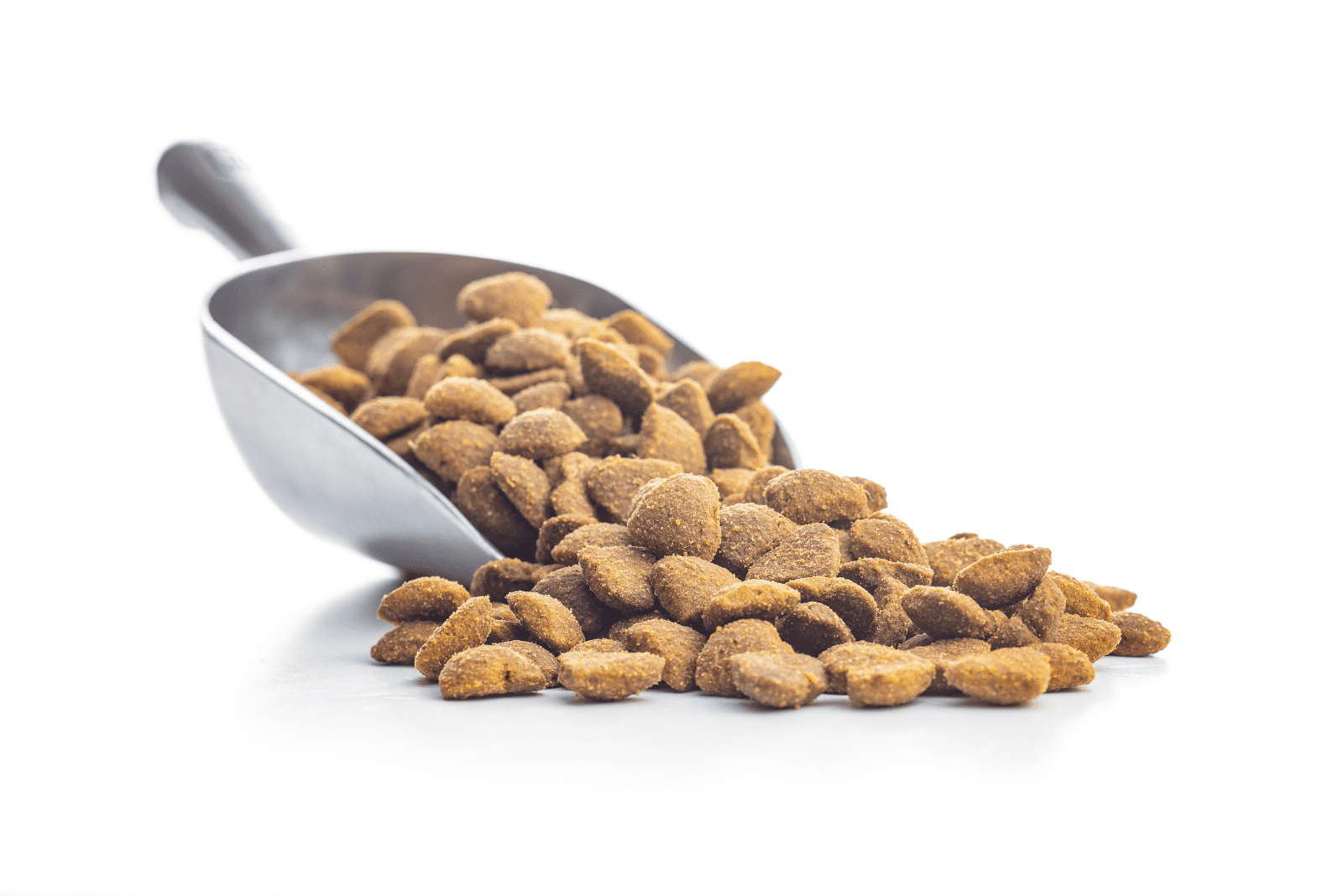
Kibble is the most common type of dry commercial dog food that many Pug owners choose because it is convenient, easy to use, and storable.
Since it is widely used, this type of dog food is probably the easiest to find, and usually, dog food brands work hard to make their brand the best one on the market and stand out among the many other choices.
Usually, you can find various options for puppy food, adult dog food, or senior dog food to match your pup’s different nutritional needs perfectly.
Royal Canin is one of the dog food brands that offer exclusive, high-quality kibble for Pugs, but if you want to see what else is on the market, check out our article on the best dog food for Pugs.
Pros & Cons Of Kibble
As we have already mentioned, some of the evident pros of kibble include convenience and easiness when it comes to using the food, as well as storing it away. You can easily store it without being afraid that it will go bad.
Kibble food brands offer various formulas specifically made for different breed sizes and ages that will provide the best nutritive value for every Pug dog. It also doubles as treats, and it can be used in training for positive reinforcement.
On the other hand, the downside of this dog food is that it can be dehydrating, and you need to be careful and provide your dog with enough fresh water throughout the day.
Often, unfortunately, kibble can be made from human food scraps and not include the best ingredients, so you need to be careful about that also. Make sure to brush your dog’s teeth regularly because this food can often be oily and sticky.
Wet Food
Commercial wet food is another great option for Pug dog food. Usually, it contains similar ingredients as dry dog food, but it is more nutrient-dense, and offers better hydration for dogs since it contains higher water content compared to the dry counterpart.
Many dog owners actually opt for the combination of dry dog food and wet food, which provides the dog with the best of both worlds, and helps keep its optimal healthy weight.
Pros & Cons Of Wet Food
Wet food, for the most part, contains fresher ingredients and real, whole meat that is a great source of protein for dogs. It also rarely contains grains, and is mostly grain-free, which is better for dogs that have a sensitive stomach or some food allergies.
Compared to kibble, wet food is not as easy to store. Once it is opened, it has to be refrigerated and eaten within a certain period of time; otherwise, it will go bad. It is also much more expensive than dry dog food, and not suitable for every owner’s price range, especially when feeding adult dogs.
While many Pug owners love the wet food option for their little pups, some have reported that it has made their dog’s stool softer if they only feed their pups with it.
Raw food
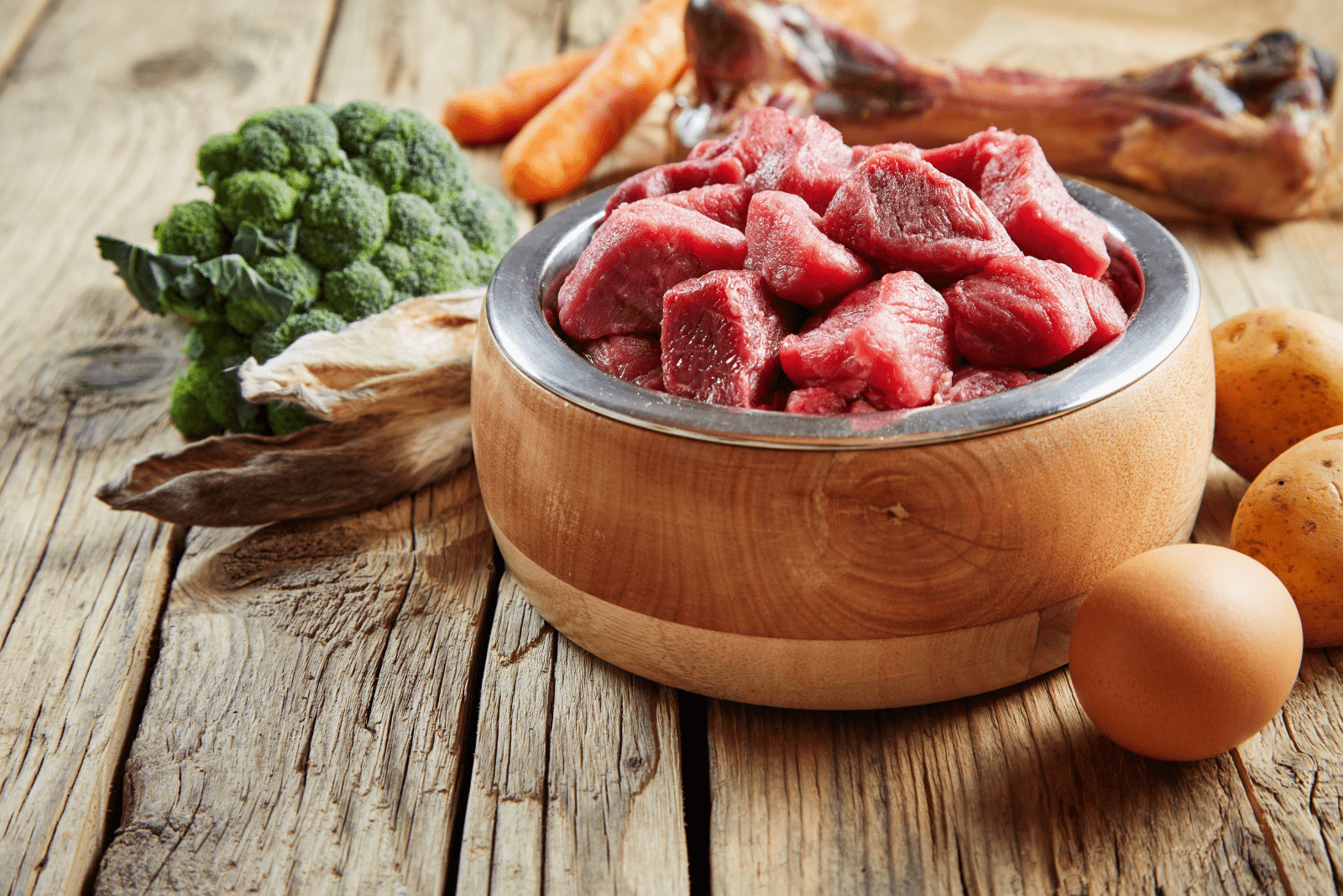
Raw food (also called BARF, which is an acronym for Biologically Appropriate Raw Foods) is another dietary option that, lately, many people advocate for.
By popular opinion, this diet is the healthiest form of feeding your Pug because you have complete insight into the ingredients you are feeding your doggie.
The idea behind BARF comes from nature and what wild dogs and dogs in the past used to eat — small animals or whatever they could catch in nature. Raw food usually includes high-quality meat, bones, and animal organs.
Pros & Cons Of Raw Food
The pros of raw food are that this type of food is said to be much healthier for a dog’s general health and immune system. It provides optimal dental health, a smoother and shinier coat, better digestion, and less allergic reactions.
Raw food does not contain any fillers, additives, or preservatives, and you can be completely sure that you are feeding your pup with high-quality dog food.
On the other hand, the cons of this dog food are that it is more expensive and more difficult to store as it will take up a lot of freezer space. You need to get accustomed to dealing with it, and learn how to prepare it, which requires valuable time. It takes a lot of commitment to actually stick with it.
Homemade Food
Lastly, you can choose to feed your dog home-cooked food. Not many people actually decide to do this as you have to be able to prepare it, but in recent years, it has started to become more popular and widely spread.
If home-cooked food is better for babies and humans, why wouldn’t it be better for dogs and puppies as well?
Pros & Cons Of Homemade Food
With home-cooked food, you get a lot of advantages and benefits for your dog. The best thing is that you can control all the ingredients and provide your dog with only the best of the best. You can specifically customize it to match your dog’s needs and preferences perfectly.
There are no added preservatives, by-products, or harmful additives, and you can control which supplements your dog gets to have. If you consult your veterinarian, you can prepare the perfect feeding guide that will provide your dog with the maximum amount of health benefits.
On the other hand, the obvious negatives of this diet are that you have to prepare it by yourself, which takes time, will, and space to store it. You have to first learn everything about puppy feeding, adult feeding, and senior dog feeding in order to be able to cook everything.
It is also very expensive, either if you buy already home-cooked food or if you only buy the ingredients, which usually tend to be more expensive due to the natural background.
RELATED: 7 Vet-Approved Homemade Dog Food Recipes For Kidney Disease
Treats And Snacks
Even though it is not a full diet per se (at least it shouldn’t be), it is important to mention it because treats and snacks are a huge part of your dog’s lifestyle, and it is important that you also choose healthy ones that will benefit your dog.
Between the regular meal servings, you can feed your dog some healthy snacks twice a day, and use treats when you want to train your dog or reward him/her for good behavior. When choosing which snack/treat to use, follow the same feeding guidelines as for normal meals.
Choose something that is made from all-natural ingredients, low-calorie, and contains only good ingredients that will benefit your dog. Make sure to always feed your dog the right amount of treats/snacks, so you don’t accidentally overfeed your pup and cause more harm.
What Pugs Should/Shouldn’t Eat
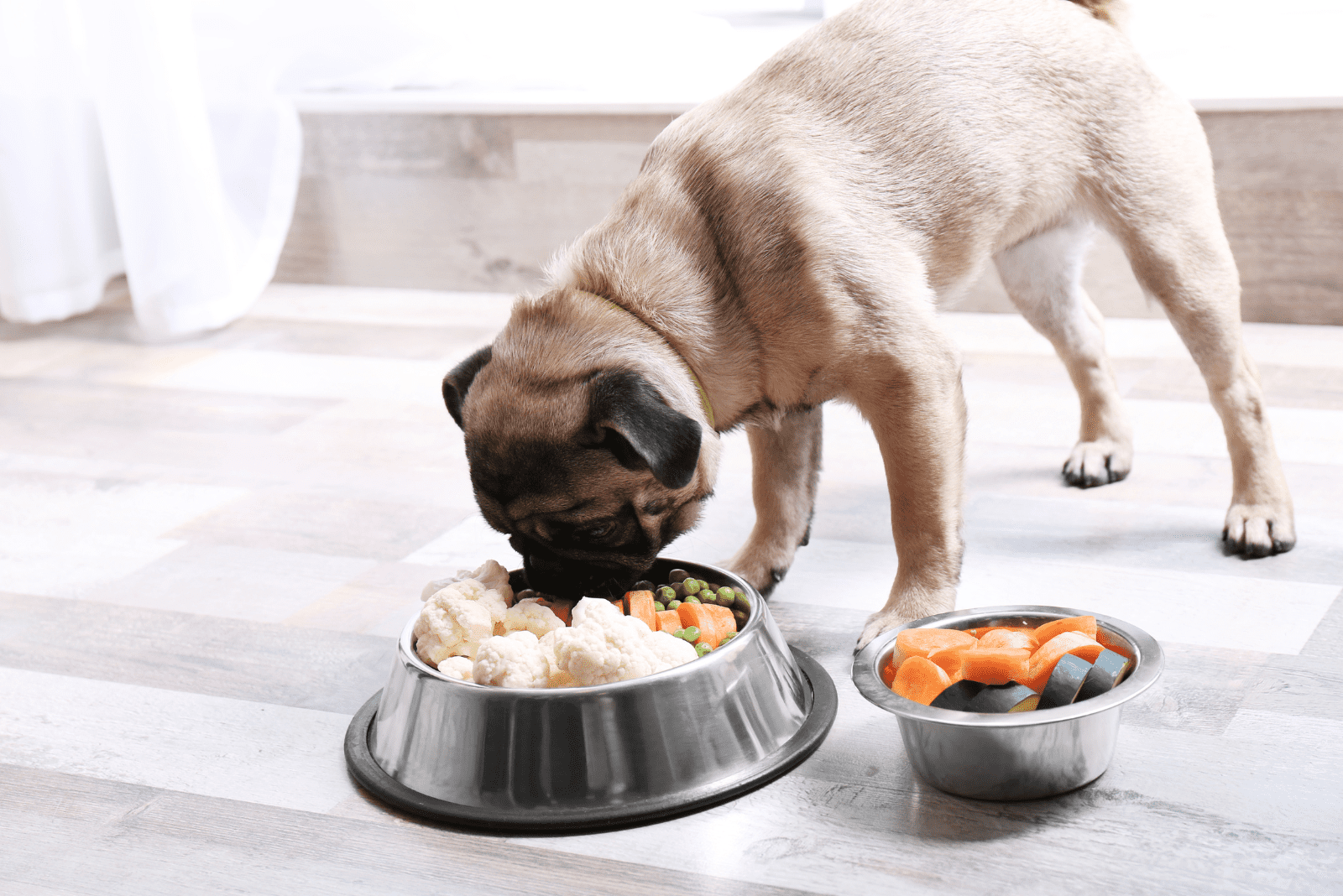
While there are some foods that will help keep your dog healthy and fit, there are also some foods that should be avoided because they are either toxic or not good for your dog’s health.
With so many choices that are available on the market, it is hard for Pug owners to know which foods are good for their little pup and which are not. Therefore, we bring you a little guide on your Pug’s healthy feeding habits, and what you should definitely avoid.
When in doubt, it is always better to consult your veterinarian rather than cause harm to your beloved family member.
Green-Light Food
Pugs, being the food lovers that they are, will eat everything that you put in front of them, but when it comes to certain human foods, some are extremely good for their diet, and you should try to implement them in their lifestyle as much as possible.
Fresh baby carrots are a great option for a snack or a dog treat because they offer many nutritional benefits, improve their digestive system, and keep their teeth clean.
They are low in calories and fats, but filled with fibers, vitamin A, and Beta-carotene, which are great sources of natural supplements for their overall health.
Boiled potatoes (sweet potatoes, especially), spinach, peas, kale, cauliflower, and green beans are also some of the veggies that are great for Pugs to eat.
Meat is a great source of protein, and should definitely be a part of the Pugs diet – either raw or cooked. When given in appropriate amounts, lean meat like chicken, lamb, fish, and beef will provide your Pug with all sorts of nutrients, but will not affect his weight gain.
RELATED: How To Boil Chicken For Dogs: Everything You Need To Know!
Red-Light Food
There are certain foods that are not good for your Pug, and certain foods that are extremely poisonous and can even be fatal in the worst-case scenario. A pug’s stomach can be very sensitive, and eating certain food can make them very sick.
In order to avoid this, it is better to completely avoid feeding them anything on this list. Write it down or memorize it, so that you or someone from your family doesn’t accidentally give any of these to your beloved doggie.
If it happens, though, don’t wait for your dog’s reaction because then it could be way too late. Contact your veterinarian, and if he feels it is necessary, bring your pup in for an emergency visit.
So, what food should you not give to your Pug?
Chocolate, grapes, raisins, anything from the onion family (onions, garlic, leeks, and chives), avocado, cooked bones, macadamia nuts, walnuts, coconut (oil), alcohol, coffee, tea, and nutmeg are just some of the fruits, veggies, and food products that you should avoid giving to your Pug.
Additionally, artificial sweetener (xylitol) that can be found in mints, gums, and other household items, as well as food (candy, cereal, toothpaste, baked goods…), is extremely toxic to Pugs.
Just a small amount of this sweetener could affect its blood sugar levels, and a high amount could damage its liver and possibly kill it, so it is very important to be extremely careful with this ingredient.
Even certain peanut butter brands contain this sweetener, so make sure to read the ingredient list before you give your pup this treat.
Other food that could be dangerous includes corn on the cob, peaches, cherries, meat and eggs that haven’t been cooked properly, dairy products, blue cheese, and food with high sugar and salt content.
READ ALSO: Can Dogs Eat Rice Cakes? Foods We Can Safely Share With Dogs
Why Is My Dog Always Hungry?
The Pug dog breed is known for always wanting to eat no matter if you just fed him, as soon as you start to eat, or if food is involved – he will be right next to you begging for more.
A lot of other dogs will welcome the opportunity for food, not just Pugs, but they are especially known as food lovers. This doesn’t have to mean that they are hungry… they just can’t resist food in general.
If you are following the Pug feeding chart and all the feeding guidelines with the correct amount of food, you shouldn’t be feeding your dog more no matter how much he begs you.
They might give you a puppy look that you can’t resist, but you have to keep in mind that overfeeding your Pug can lead to obesity and many other health issues that can affect your dog’s lifestyle and general lifespan.
If you are ever in doubt about your dog’s feeding needs, speak to your veterinarian who will be able to give you professional advice on the matter and assess the situation in a more detailed way.
READ ALSO: My Puppy Is Always Hungry – When To Stop Feeding
How Much Water Should My Pug Drink?
Keeping your dog hydrated is as important as feeding your dog properly (if not even more important). Pugs, being a brachycephalic breed, are even more at risk of dehydration, so their water intake is extremely crucial for keeping them healthy.
On average, dogs need around one ounce of water for every pound of their body weight, but Pugs require a little bit more. Approximately 1.25 ounces should be good for Pugs, but this number can go up to even two ounces per pound if your dog is extremely active or if the weather is too hot.
So, depending on your dog’s body weight, his lifestyle, and the environment you live in, his water intake should change accordingly. Let’s look at the water intake chart to better understand how much water your Pug should drink daily:
[table id=545 /]
Is your dog having some issues drinking water, like coughing? Read this article, and find out 6 reasons why dogs cough after drinking water, and how to help!
To Wrap Up
Pugs are sweet animals that can be perfect family members, but there is one thing about these doggies that every dog owner must know — they love to eat!
If you are not careful about their feeding habits, they will soon become obese or develop some other health issues. However, if you are following a Pug feeding chart and maintaining its healthy weight, there shouldn’t be problems.
Keep in mind that every dog is a little bit different and, therefore, might require different treatment, but you can always use this feeding chart as a starting point, and customize it to perfectly match all your dog’s needs.
Choose what works the best for you and, most importantly, for your dog, but make sure that it always fits the Pug’s healthy standards. This is the only way to keep your Pug-bug healthy and fit for a long time.
Owning a Pug is definitely a responsibility; however, all of this shouldn’t take away the fun of having the perfect little furry friend by your side. Remember, you can do it! Once you get the hang of it, feeding your doggie will be easy-peasy.
